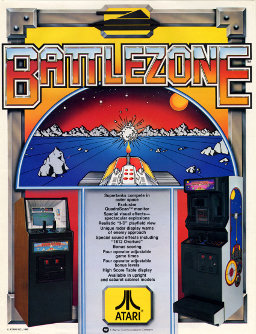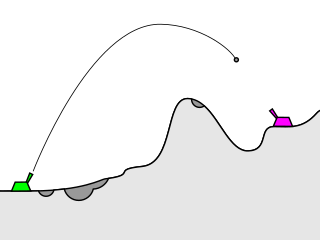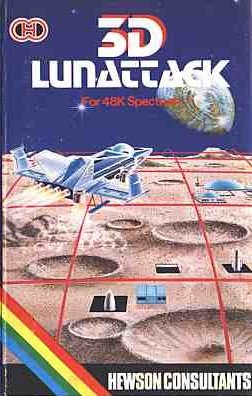
Battlezone is a first-person shooter tank combat game released for arcades in November 1980 by Atari, Inc. The player controls a tank which is attacked by other tanks and missiles. Using a small radar scanner along with the terrain window, the player can locate enemies and obstacles around them in the barren landscape. Its innovative use of 3D graphics made it a huge hit, with approximately 15,000 cabinets sold.

Operation Thunderbolt is a light gun shooter video game developed by Taito and released for arcades in 1988. As the sequel to Operation Wolf, changes include two-player gameplay with two positional gun controllers mounted on the arcade cabinet, and a new forward-scrolling pseudo-3D perspective combined with side-scrolling sections.
CDS Software was an independent publisher and developer of computer game software based in Doncaster, South Yorkshire, UK.

BattleTanx: Global Assault is an action game developed and published by The 3DO Company for the Nintendo 64 and PlayStation, in which players control futuristic tanks in a post-apocalyptic scenario. It is a sequel to the Nintendo 64 game BattleTanx, which utilized the same method of game play. Although it earned relatively positive reviews from critics, 3DO went bankrupt before another sequel could be released.

Gunfright is an action-adventure game developed by Ultimate Play the Game and published by U.S. Gold. It was first released for the ZX Spectrum in December 1985, then released for Amstrad CPC and the MSX the following year. The player takes the role of a sheriff in the town of Black Rock and is tasked with eliminating outlaws who are scattered throughout the settlement.

BattleTanx is a 1998 action game released for the Nintendo 64, produced by The 3DO Company. The game was followed by a 1999 sequel, titled BattleTanx: Global Assault.

Deathchase is a 1983 vehicular combat game written for the ZX Spectrum by Mervyn Estcourt and published by Micromega in the UK. In Spain it was published by Ventamatic. The "3D" designation on the box led to the game sometimes being misnamed "3D Deathchase", including in reviews. Timex USA published Deathchase for its range of computers in the US as Cyclepath.

Arcticfox is a science fiction tank simulation video game developed by Dynamix and published by Electronic Arts in 1986. It was published in Europe by Ariolasoft. A sequel to Dynamix's Stellar 7, it was released on Atari ST, Commodore 64, ZX Spectrum, MS-DOS, and Apple II. A third game was released in the series in 1991 titled Nova 9: The Return of Gir Draxon.

Artillery games are two or three-player video games involving tanks trying to destroy each other. The core mechanics of the gameplay is almost always to aim at the opponent(s) following a ballistic trajectory. Artillery games are among the earliest computer games developed; the theme of such games is an extension of the original uses of computer themselves, which were once used to calculate the trajectories of rockets and other related military-based calculations. Artillery games have been described as a type of "shooting game", though they are more often classified as a type of strategy video game.

Android Two is a shoot 'em up maze video game written by Costa Panayi and published by Vortex Software in 1983 for the ZX Spectrum and in 1985 for the Amstrad CPC. It is the sequel to Android One: The Reactor Run, released earlier in 1983.
DK'Tronics Ltd was a British software and hardware company active during the 1980s. It primarily made peripherals for the ZX Spectrum and Amstrad CPC but also released video games for the ZX81, ZX Spectrum, Commodore 64, VIC-20, BBC Micro, Memotech MTX, MSX and Amstrad platforms.
Don Priestley is a teacher and former video game programmer who wrote over 20 commercial games for the ZX81 and ZX Spectrum home computers between 1982 and 1989. Despite successful releases for DK'Tronics, such as 3D Tanx and Maziacs, Priestley returned to teaching in the late 1980s, claiming changes in the video game industry did not suit his style of work.

In video games, first-person is any graphical perspective rendered from the viewpoint of the player character, or from the inside of a device or vehicle controlled by the player character. It is one of two perspectives used in the vast majority of video games, with the other being third-person, the graphical perspective from outside of any character ; some games such as interactive fiction do not belong to either format.

Thunder Blade is a third-person shoot 'em up video game released by Sega for arcades in 1987. Players control a helicopter to destroy enemy vehicles. The game was released as a standard stand-up arcade cabinet with force feedback, as the joystick vibrates. A helicopter shaped sit-down model was released, replacing the force feedback with a cockpit seat that moves in tandem with the joystick. It is a motion simulator cabinet, like the previous Sega Super Scaler games Space Harrier (1985) and After Burner (1987). The game's plot and setting was inspired by the film Blue Thunder (1983).

The Seiddab Trilogy is a series of video games designed by Steve Turner for the ZX Spectrum and published by Hewson Consultants. It consists of 3D Space-Wars (1983), 3D Seiddab Attack (1984), and 3D Lunattack. All three games were later published together as The Seiddab Trilogy by Hewson for the Rotronics Wafadrive. The series name is derived from the word "baddies" being spelt in reverse.

Battle Command is a futuristic 3D tank simulation game released by Ocean in 1990. It was written by Realtime Games and is a development of their successful title Carrier Command.

3D Space Wars is a space combat video game written by Steve Turner for the ZX Spectrum and published by Hewson Consultants in 1983. It is both the first game written by Turner and the first in the Seiddab Trilogy.

PlayCanvas is an open-source 3D game engine/interactive 3D application engine alongside a proprietary cloud-hosted creation platform that allows for simultaneous editing from multiple computers via a browser-based interface. It runs in modern browsers that support WebGL, including Mozilla Firefox and Google Chrome. The engine is capable of rigid-body physics simulation, handling three-dimensional audio and 3D animations.















